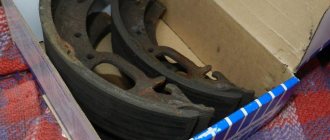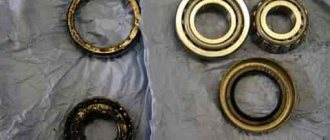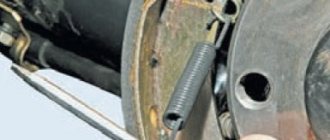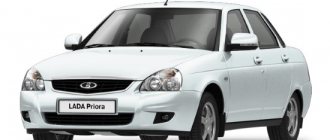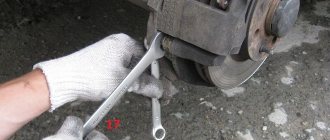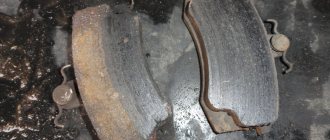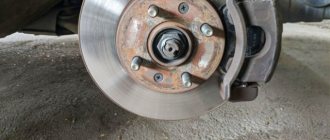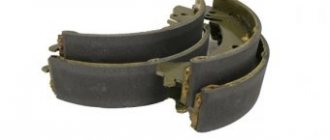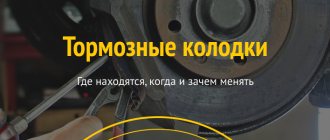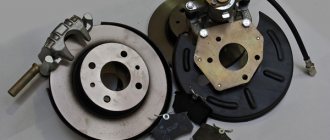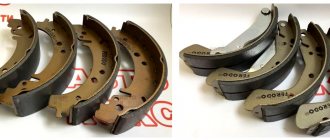Lift the rear of the car and remove the wheel. Take measures to prevent fluid from leaking from the tank.
Rice. 7–14. Rear wheel brake drum: 1 — bolts securing the drum to the axle shaft; 2 - threaded holes for installing bolts 1 when removing the drum
Remove the brake drum by unscrewing the mounting bolts 1 (Fig. 7–14). Insert these bolts into technological holes 2 and tighten until the drum separates.
Rice. 7–15. Rear wheel brake mechanism: 1 - wheel cylinder; 2 — upper tension spring of the pads; 3 — pad lining; 4 — brake shield; 5 — inner plate; 6 — rear cable sheath; 7 — lower tension spring of the pads; 8 — front brake pad; 9 — pad support plate; 10 - rivets; 11 — oil deflector; 12 — pad guide plate; 13 — rear parking brake cable; 14 — rear cable spring; 15 — rear cable end; 16 — rear brake pad; 17 — block support post; 18 — lever for manual drive of the pads; 19 — rubber cushions; 20 — pad spacer; 21 — finger of the lever of the manual drive of the pads
Disconnect cable tip 15 from lever 18 (Fig. 7–15) of the manual drive of the shoes, remove the cotter pin, press pin 21 and remove the lever. Use pliers to disconnect the upper 2 and lower 7 tension springs. Having turned the cups of the support struts 17, remove them together with the struts, springs and lower cups; remove pads 8 and 16 and spacer bar 20. Disconnect the brake fluid supply tube from the wheel cylinder and plug the inlet holes of the cylinder and tube. Remove the wheel cylinder. When replacing the brake shield, remove the axle shaft as indicated in the “Rear Axle” chapter and disconnect the parking brake cable by unscrewing the two bolts securing it to the brake shield.
Assembly and installation
Install and secure the wheel cylinder to the brake shield, attach the brake fluid supply pipe to it and tighten the fitting nut completely. Attach lever 18 (see Fig. 7–15) for manual drive of the shoes to the block and install brake pads with spacer bar 20, then install racks 17 with springs and lower cups, place the upper cups and fix them on the racks by turning in one direction or the other . Make sure that the ends of the pads are correctly positioned in the stop sockets on the wheel cylinder pistons and on the brake shield. Install the shoe tension springs. Attach the tip 15 of the rear cable to the lever 18. Install the brake drum, having previously lubricated the seating belt of the axle shaft with graphite grease or LSTs-15 grease and tighten the drum mounting bolts until full. If the wheel cylinder was removed during disassembly, remove air from the rear brake drive circuit.
Disassembly and assembly of wheel cylinders VAZ 2107
Rice. 7–16. Wheel cylinder: 1 — pad stop; 2 — protective cap; 3 - cylinder body; 4 - piston; 5 - seal; 6 — support cup; 7 - spring; 8 - crackers; 9 — thrust ring; 10 - thrust screw; 11 - fitting; A - slot on the thrust ring
Remove the protective caps 2 (Fig. 7–16), then press the pistons 4 assembled with the parts of the device for automatically adjusting the gap between the brake pads and the drum out of the cylinder body.
Rice. 7–17. Wheel cylinder parts: 1 - piston assembly; 2 — cylinder body; 3 - thrust screw; 4 - thrust ring; 5 - crackers; 6 - spring; 7 — support cup; 8 - seal; 9 - piston; 10 - protective cap
Install the piston assembly with the automatic device on a special device so that the protrusions of the device cover the head of the thrust screw 3 (Fig. 7–17). Using a special screwdriver, turning piston 9, unscrew the stop screw 3 from the piston. Remove seal 8 with support cup 7 and crackers 5 from the screw. Separate the thrust ring 4 and the thrust screw 3. Assemble the automatic device for adjusting the gap between the shoes and the drum and the wheel cylinder itself in the reverse order, taking into account the following: - torque the piston thrust screws 3.9–6.9 N m (0.4–0.7 kgf m); Slot A (see Fig. 7–16) on the rings should be directed vertically upward; deviation from the vertical is allowed no more than 30°. This arrangement of the slot ensures more complete removal of air from the wheel brake drive when bleeding the brake; — to pre-compress the thrust rings, press the pistons into the cylinder body using a special device shaped like a cylinder with a conical internal hole; — the force of pressing the piston into the cylinder must be at least 343 N (35 kgf); if the force is less than 343 N (35 kgf), replace the thrust ring; — when pressing the piston into the cylinder, it is necessary to maintain dimensions of 4.5–4.8 mm and 67 mm (maximum) (see Fig. 7–16) for a free fit of the brake drum; — before installing parts into the cylinder body, lubricate them generously with brake fluid. After assembly, check the movement of each piston in the cylinder body. They should move easily within 1.25–1.65 mm. Replace the protective caps 2 last.
Wheel cylinders. Check the cleanliness of the working surfaces of the cylinder, pistons and thrust rings. The surfaces must be completely smooth, without roughness, to prevent fluid leakage and premature wear of seals and pistons. Eliminate defects on the cylinder surface by lapping or grinding. However, increasing the internal diameter of the cylinder is not allowed. Check the condition of the thrust screw 3 (see Fig. 7–17), spring 6, support cup 7 and cotters 5. If necessary, replace damaged parts with new ones. Replace the seals 8 with new ones. Check the condition of the protective caps 10 and replace them if necessary. Pads. Carefully check the pads for damage or deformation. Check the elasticity of the tension springs, both upper and lower; if necessary, replace them with new ones. The springs must not have residual deformations when stretched with a force of 343 N (35 kgf) for the lower springs and 411 N (42 kgf) for the upper ones. Check the cleanliness of the linings, if dirt or traces of grease are found, thoroughly clean the linings with a wire brush and rinse with white spirit, in addition, check for any leakage of grease or oil inside the drum; eliminate the faults. Replace the pads with new ones if the thickness of the linings is less than 1.5–2 mm. Brake drums. Inspect the brake drums. If there are deep grooves or excessive ovality on the working surface, rebore the drums on the machine. Then use a lathe to sand the drums with fine-grained abrasive stones. This increases the durability of the linings and improves uniformity and braking performance. The largest permissible increase in the nominal diameter of the drum (250 mm) after boring and grinding is 1 mm. The limits of this tolerance must be strictly observed, otherwise the strength of the drum as well as the braking efficiency will be compromised. Next page""""""
- 1.2.3.4.5.6.7.8.9.10.11.12.13.14.15.16.17.18.19.20.21. 22.23.24.25.26.27.28.29.30.31.32.33.34.35.36.37.38.39.40. 41.42.43.44.45.46.47.48.49.
Working mechanisms
The VAZ Oka uses two types - disk (in the front) and drum (on the rear bogie).
The front mechanisms consist of non-ventilated discs fixed to the hub, calipers with a so-called floating bracket and friction pads installed in special guides mounted on the stationary part of the hub.
The caliper is single-piston, so the working piston acts only on one pad, but due to the floating caliper, when braking, the caliper itself, with its body, also presses the second pad to the disc.
The rear mechanisms consist of:
- Brake shield;
- Drum;
- 2 pads;
- Working cylinder (two-piston);
- Parking brake mechanism;
The shield is a stationary element and a number of components are fixed to it - a cylinder, pads, and a handbrake mechanism. The brake drum is part of the wheel hub and is movable (rotating).
In general, the working mechanisms are identical in design to the VAZ-2108, but the dimensions differ - the diameter and thickness of the brake disc are smaller, and accordingly the pads and caliper are also more compact. The same applies to the rear mechanisms.
Useful tips
Finally, we will give some tips regarding replacing drums:
- Nowadays this part is often offered, made of aluminum
. In fact, there is no practical sense in such a replacement; - When you have the drum removed, do not press the brake pedal. This will damage the slave cylinder.
As you can see, there are no special rules or difficulties here. Knowing how to remove the brake drum on a VAZ 2107, you can easily complete this job, saving on a trip to a car service center. When performing any repairs, always check the operation of the brakes after completion; this must be done.
Brake drum installation
Before installing a new brake drum, it is necessary to sand the seating surface on the flange from rust and dirt. Then lubricate it, as well as the new drum at the point of contact with the flange, with graphite high-temperature grease. This will make it easier to disassemble the unit later.
Next, you should check the brake fluid level in the reservoirs, and if it reaches the maximum level, pump out some using a syringe. The fact is that when the brake pads are brought together, the pistons of the brake cylinders are recessed and the brake fluid can be squeezed out through the top of the reservoir.
The blocks are brought together using pry bars used as levers. To do this, their ends rest against the side of the shield, and the mounts themselves are brought together, squeezing the pads until they stop.
Note: if, after the pads are brought together, they prevent the new drum from moving into place, you must release the handbrake cable. To do this, you need to unscrew the adjusting nut located under the bottom of the car.
When the brake drum is in place, it should be centered so that the holes in its housing coincide with the mounting holes on the flange. If done correctly, the guide pins should screw into the hub and not push against it.
After installing the drum, you should get into the car and press and release the brake pedal several times to make the brake mechanism work. After this, it is imperative to check the level of brake fluid in the reservoirs and add it if necessary. You will also have to adjust the tension of the handbrake cable, even if it did not have to be released when installing the drum. The inner diameter of the working surface of the new drum is smaller than that of the old one, therefore, if the handbrake is not adjusted, the pads may rub against the drum while driving, which, at best, will cause their premature failure. In the worst case, friction can cause the brake mechanism to become very hot and the brake fluid to boil, causing the brake system to fail.
Signs of brake drum fatigue 2108
During normal operation, the rear brake drum does not require any additional inspection or maintenance. If the brakes function normally, then there should be no complaints about the drum. It should only come into view when replacing brake pads or when there is a malfunction in the handbrake drive. If the handbrake stroke has increased, but tightening it no longer gives any results, then you need to check the condition of the brake pads and, most likely, replace them. If there is a question about replacing the pads, then it is better to install either branded VAZ ones or Ferodo ones. There will be a guarantee that they will last the entire declared service life. To replace the pads we will need to remove the rear brake drum.
How to change rear brake pads yourself
Before you start replacing worn parts, you need to carefully inspect other mechanisms to make sure that there are no other “surprises”. Together with the drum system, they often break down: the drum, the cylinder leaks, the handbrake cable gets jammed.
Video
For effective repairs, the car must be driven into a hole or jacked up. Regardless of the brand and features of the mechanism, the process of replacing brakes is carried out in several phased steps:
- The wheel is dismantled.
- Inside the hood, the brake tank cover is removed;
- Parts are cleaned of dirt.
- The guide bolts are unscrewed.
- The pads are removed with a screwdriver and replaced in pairs.
- The system is checked upon ignition.
Working with a drum system is much more difficult than working with discs. However, if you follow the rules and take your time, this experience will become a useful skill that will help you deal with similar problems on your own in the future.
Interesting to know!
Note! Rear brakes have an average mileage of about 50 thousand km, front brakes last much less - from 10 to 15 thousand
km. The check is carried out every 10 thousand kilometers.
Required tools and materials
To perform repairs yourself, you need to purchase special tools. Buying at the market or second hand increases the chances of getting low-quality products. Counterfeits, although they look like the original, will not last long.
Causes and signs of rear brake failure
The rear brake mechanism of the VAZ 2107 has one extremely unpleasant feature: it easily overheats. This is due to the design of this mechanism, which is very poorly ventilated. According to the manufacturers, the rear brakes of the “Seven” can be guaranteed to last 60 thousand km without repair, while the front brakes can only last 30 thousand km. In practice, due to the above overheating, the mileage of the rear brakes is slightly lower, about 50 thousand km. After this, the driver will inevitably have to deal with the following phenomena:
- the pads in the brake mechanism wear out partially or completely, and wear can be observed on one side or on both;
Rear pads are worn down almost to the ground - the seals in the working cylinder crack due to high temperature, as a result of which the tightness of the device is broken, which leads to brake fluid leaks and a sharp drop in braking efficiency;
- the return springs in the brake mechanism rust heavily (in especially severe cases, one of them may break, which can lead to the rear wheel jamming);
- The handbrake cable wears out. When the cable wears out, it stretches and begins to sag a lot. As a result, after putting the car in handbrake, the brake pads put much less pressure on the drum wall, and the rear wheels are fixed very precariously.
Taking into account all these points, it is strongly recommended to check the rear brake mechanism every 20 thousand km and, if necessary, carry out its maintenance. Particular attention should be paid to the rear brakes if the following warning signs appear:
- when braking, a strong vibration of the car appears, which the driver feels literally with his whole body;
- after pressing the brakes, a strong squeaking sound occurs, which over time can turn into a deafening grinding sound;
- when driving there is a strong “beating” of both the steering wheel and the brake pedal;
- braking efficiency has dropped significantly, and the braking distance has become much longer.
All these signs indicate that the brakes need urgent repairs or serious preventive maintenance. It is absolutely forbidden to drive with such brakes.
Brake drum cracks
Cracks are a real scourge of all brake drums, not only on “sevens”, but also on many other cars with drum brakes. The vast majority of the warning signs listed above appear precisely after the drum cracks. This happens especially often with cast iron drums. The fact is that cast iron is an alloy of iron and carbon, which contains more than 2.14% carbon. Carbon gives cast iron incredible hardness, but it also makes cast iron brittle. If the driver does not have a careful driving style and really likes to ride with the breeze over potholes, then cracking of the brake drums is only a matter of time.
Drum crack caused by metal fatigue
Another reason for drum cracking is so-called metal fatigue. If a part is subjected to cyclic alternating loads for a long time, accompanied by an abrupt change in temperature (and the brake drum operates precisely under such conditions), then sooner or later a fatigue microcrack will appear in such a part. It is impossible to see it without an electron microscope. At some point, this crack propagates deep into the part, and the propagation occurs at the speed of sound. As a result, a large crack appears, which is impossible not to notice. A cracked drum cannot be repaired. Firstly, welding cast iron in a garage requires special equipment and skills, and secondly, the strength of such a drum after welding will be significantly reduced. So the car owner has only one option: replace the cracked brake drum with a new one.
Wear of the inner walls of the drum
Wear of the inner walls of the drum is a natural process, the results of which are clearly visible after the car has covered the above-mentioned 60 thousand km. Since the inner walls of the drum are periodically subjected to the frictional force created by the friction linings on the brake pads, the inner diameter of the drum inevitably increases over time. Braking efficiency is reduced because the brake pads are less pressed against the drum. The effects of normal wear are eliminated by regrooving the brake drum and then adjusting the brake mechanism to ensure proper contact of the pads with the inner walls.
Grooves on the inner surface of the drum
The appearance of grooves on the inner surface of the drum is another common problem that owners of “sevens” often encounter. The fact is that the rear brakes on the “seven” are designed in such a way that dirt and small stones sometimes get into the drum, especially if the driver drives mainly on dirt roads. One or more stones may become lodged between the brake pad and the inner wall of the drum. When the block presses the stone against the inner surface of the drum, it is pressed deeply into the friction lining on the brake shoe and remains there (the material of the friction linings is quite soft). With each subsequent braking, stones stuck in the block scratch the inner wall of the drum.
Large scratches are visible on the inner wall of the drum
Over time, a minor scratch turns into a large groove, which will not be so easy to get rid of. The way to solve this problem is determined by the depth of the grooves that appear. If the driver noticed them early and their depth does not exceed one millimeter, then you can try to get rid of them by grooving the drum. And if the depth of the grooves is two millimeters or more, then there is only one way out - replacing the brake drum.
Replacement of rear brake pads, for fun, correct it please
IDIOT advice was given to you by an IDIOT, which you CANNOT follow. Unfortunately, the advice is well known. And extremely DANGEROUS. 1. Serviceable pads do not need to be filed. 2. Worn, at least slightly worn pads are replaced AS A SET. Better on both sides at once. Because the seed’s flame and mine were lower here - the seed there spoke well about different resistance coefficients, etc. And I - what is acceptable, if one pad is completely new, do not replace it as a set. The pads must be the IDENTICAL, from the same batch with the same wear, without thermal overheating. If the wear is uneven, you should consider replacing the brake cylinder or looking for the exact cause of the uneven wear. Uneven wear is dangerous! By the way, it is better to change the pads at 80% wear. You will live longer. Sergey 77
Not at all. Since many people often change pads one at a time, they sell them at retail. And when I needed 1 pad, and the guy only sold it as a set, it began to cost 3 rubles more.
: *** An even more correct option is to put shoes (stones, other stops) under the wheels (on the side opposite to the one being jacked), because there is ALWAYS a risk that when the load on one of the wheels is loosened, the differential will play and you will drop your car .
: *** Buy a 27mm wrench and a socket and use them to unscrew the nut. Much more convenient, the tool will be useful in the future.
Yes, there the nut can almost be unscrewed by hand. I always have an adjustable wrench just in case (I use it to change the Carlson sensor), but I don’t carry a 27 wrench. BUT I will partially correct it.
: ***Throw out the old oil seal in any case - the probability of soon repeating all the described movements is too high due to the cheap part (which, after 60-90 tkm, see above, has already turned from rubber to wood).
Dismantling and installation
Of course, you will not be able to install new disc brakes on the rear axle of the VAZ 2110 until you remove the drum mechanisms. To dismantle them, do the following:
- The wheel is removed;
- The drum is dismantled;
- The pads are removed;
- The brake pipe is unscrewed;
- The hub is removed from the wheel.
In words it looks simple, that's a fact. But in reality, certain difficulties may arise. First of all, due to sticking of elements and sticking of fastening bolts as a result of corrosion. In order not to suffer with them, treat them in advance with the almighty WD40, which will dissolve rust and “scale”, and remove them without serious effort or harm to the edges of the fasteners.
Fastener drawingsNow we proceed to the installation, in which the old drums are sent to their well-deserved rest, and new disc brakes take their place.
- When you knock off the hub, it needs to be put back in place.
- Install the element through a plate with a caliper built into it.
- Make sure all holes line up and alignment is correct.
- Use a hammer to adjust the angle of the beam. The caliper should not rest against it.
- Place the brake disc on the hub. A spacer is placed between the elements and the disk is fixed with brackets in its new place.
- Now install brake pads selected specifically for the VAZ 2110.
- First, attach the brake hose to the caliper, and then connect it to the pipe.
- The friction material of the pad must be partially worn off. This is necessary so that the braking force on the rear brakes is less than on the front.
How to remove a stuck drum in a classic
In rear-wheel drive vehicles, when replacing rear brake pads, rear brake cylinders and axle shafts, there is no way to do without removing the rear brake drum. In theory, this is simple to do, but how to remove a stuck drum, for example, in a classic, which during the run under the influence of dirt, dust, and moisture firmly sticks to the wheel hub. Let's first consider the theory that is described in “Murzilka” (as VAZ car enthusiasts call the “Car Operating Instructions”). It says: to remove the rear drums on a VAZ 2101 - 2107 you need to do the following: 1. Place the rear of the car on a jack.2. Remove the rear wheel.3. Unscrew the drum guide pins from the wheel hub.4. Screw the guide pins into the following threaded holes located on the drum.5. Diametrically and alternately, screwing in the studs, press the rear drum away from the wheel hub.6. Rock the drum with your hands and remove it from the rear brake pads.
| The part of the drum that is adjacent to the hub or axle shaft of the car, as a rule, is heavily clogged with dust and road dirt; it must be thoroughly cleaned |
That's all: easy and simple, but in practice, given that the car has traveled more than one thousand kilometers, Murzil's recommendations do not work. Because during the first attempts, the threads for the studs break off, and along with this, the hope for this method of removing the drum disappears. But don’t immediately despair and try to knock down the drum with a hammer, which is strictly not recommended, since the drum body is made of a very fragile duralumin material. And another one will be added to your problems: buying a new rear drum. But car enthusiasts are smart people and have found several practical ways to remove a stuck drum in a classic car. Two of them are offered
The first is the simplest, but at the same time requires special care. After you have jacked up the car body and removed the rear wheel, you must firmly install this part of the body on a strong stand.
That is, so that the car does not hang on a jack, but rests, we repeat, on a strong wooden stand. And, of course, you need to install reliable stops under the front wheels
It is important!
| Start the car, turn on first gear and press the brake with a little gas; the drum without guide bolts will break off. |
Then, the driver sits behind the wheel of the car (which is hanging), starts the engine and, turning on first gear, picks up the engine speed, which transmits rotational motion to the rear wheel. Then he sharply presses the brake. What's happening? The brake pads abruptly stop the drum, but at the same time the wheel hub located on the rear axle continues to rotate. Usually the force of the brake pads is enough to tear the drum off the hub. If it doesn’t work out the first time, you need to try again, alternately alternating first and reverse speeds. Yes, I almost forgot: before doing this procedure, you need to use a metal brush to clean the edges of the hub protruding from the drum and lubricate them with any lubricant. The second method is used if for some reason you cannot reliably place the body on a stand or there is no way to use the engine (it was sent for repair, for example). But this method is interesting in itself and can be done by drivers who have some plumbing skills. It was possible to describe this method, but why, as they say, “pour water.” It is best to watch the attached video from the Internet, where the young man competently and clearly presented this process.
Removing the brake drum VAZ 2107
Before removing the drum, you must hang the car or the rear wheel on which you want to remove the drum, and be sure to lower the handbrake lever. If the work is not done on a lift, it is necessary to put shoes under the wheels so that the car does not roll or fall off the jack. Otherwise, you can not only damage the jack, brake mechanism or car body parts, but also cause serious injury.
When the car is raised and secured, the further sequence of operations is as follows:
- Remove the wheel from the car.
- Using a spanner or regular wrench, unscrew the guide pins, which act as fastening the drum to the wheel hub.
- Remove the drum evenly, without distortions, pulling it off the hub and pads.
Note: if the drum cannot be removed, you can use an improvised puller made of two M8 bolts. To do this, you need to insert them into the holes on the drum and screw them in smoothly. Resting against the hub, they will push the drum out of its seat. This should be done carefully, as there is a possibility that the lip on the inner surface of the drum will damage the brake pads.
Signs that replacement is needed
The brake drum must be replaced when signs of deformation or cracking of the part appear. Another reason for replacement is wear on the drum walls. To check this, you need to get to the working surface of the part and check the internal diameter. The latter increases as the drum wears out. The maximum permissible internal diameter is 251 mm. If the measurements give a higher value, the drum needs to be replaced immediately. To do this, you need to know how to remove the brake drum of a VAZ 2107. Significant wear on the working surface of the drum also makes it difficult to remove it from the hub. This is due to the appearance of a lip along the edge of the inner surface of the drum there. The brake pads grind down the working surface, and in the place where they do not contact the drum, the metal remains intact. Over time, the difference in diameters becomes so large that when the drum is removed, the side clings to the brake pads.
When to change rear brake pads
Several factors influence pad wear:
- terms of Use;
- driving method;
- condition of the mechanism;
- quality of spare parts.
Operation in unfavorable conditions leads to a reduction in the service life of parts. Front pads (disc) wear out 2-3 times faster than the rear ones.
The mechanism may last longer if new drum brakes are installed. However, before you make the replacement yourself, you need to take into account the general technical condition of the car.
It is important not to miss the moment when the system requires an update, otherwise new problems will appear
Parts need to be replaced when signs of wear appear:
- pronounced creaking when braking (whistle, grinding, squealing);
- long pedal travel;
- shocks during a sudden stop;
- long braking distance;
- the brake pedal goes to the floor.
If one of these signs is detected, you need to urgently purchase parts. Doing the repair yourself is not at all difficult. If you put off solving the problem, the brake system will completely fail and it will not be easy to restore it.
You can correct the situation by contacting a service center, a private mechanic, or installing the pads yourself.
When should you shoot?
The job of removing a brake drum is actually quite common. This is due to a number of technical features of the domestic car. You will have to dismantle the drum in the following cases:
- Drum wear
. During operation, it gradually wears off, which leads to the need to replace it; - Installation of new brake pads;
- The need to remove the rear axle shaft.
The drum will also need to be removed if it is necessary to repair or replace any elements of the rear brake. Sometimes in this case the drum is changed. Here you need to act based on the condition of the parts on your car.
Purpose and types of brake pads
Friction is used to stop a car. In the case of the VAZ 2107, this is the friction force of the pads on the brake disc (or on the brake drum, if the pads are rear). In general, the block is a steel plate with mounting holes, to which an overlay is attached using rivets. This is a rectangular plate made of a special material with a very high coefficient of friction. If the friction coefficient of the lining decreases for some reason, braking becomes less effective. And this immediately affects the quality and safety of driving.
Front pads
To brake the front wheels, flat, rectangular paired pads are used. The front wheels of the “seven” are equipped with massive steel discs that rotate synchronously with the wheels. When braking, rectangular pads compress the rotating disc on both sides. After this, the friction force provided by the linings comes into play, and the discs and wheels stop.
The front pads of the “seven” are ordinary rectangular plates with overlays
Product added to bookmarks!
- Description
- Reviews
APPLICABILITY: VAZ 2108, 2109, 21099, VAZ 2110, 2111, 2112, VAZ 2113, 2114, 2115, VAZ 1117, 1118, 1119 (Lada-Kalina), VAZ 2170, 2171, 2172 (Lada-Priora ), VAZ 2190, 2191 (Lada-Granta), VAZ 2192, 2194 (Lada-Kalina 2).
Compared to standard ones, cast iron drums have greater rigidity, due to which they are less susceptible to deformation, less susceptible to overheating as a result of frequent braking, silumin (the alloy from which standard drums are made) is more fragile, susceptible to temperature deformation and not only (egg-shaped), while cast iron retains its shape (there will be no wobbling). Silumin sticks to the hub, sometimes even graphite doesn’t help. Cast iron is much easier to remove when replacing pads.
The largest manufacturer of automotive security systems in the world!
How to replace the brake drum on a VAZ 2101-VAZ 2107?
Note! Replacing the drum is carried out with the car hanging and the handbrake released, so keep this in mind when you start replacing!
Removal: 1) At the very beginning of the operation, you will have to remove the wheel you need from the car and then leave the car hanging in the air. (For information on how to remove a wheel, see the article entitled: “Replacing wheels on a car”)
2) Then pick up a wrench or a spanner (it doesn’t matter which is more convenient) and use it to unscrew both guide pins that secure the drum to the hub, and after the pins are unscrewed, pull the drum and thereby remove it from the car .
Note! If the drum will not be removed, then take two M8 bolts and screw them into the holes in which they will fit, but screw both bolts evenly, that is, tighten both bolts first and tighten each one a little and thus you will see how the drum starts get off the car!
3) After the drum is removed, use sandpaper to clean the mounting surface of the axle shaft flange as shown in the figure below from dirt and rust.
Note! When there is no dirt on the surface of the axle shaft flange (the surface is also indicated by a red arrow in the photo below for clarity), then using graphite grease or LSC-1 grease, lubricate this very surface of the flange, and in addition to it, also lubricate the entire place where the drum itself is installed on the axle shaft flange (This location is also indicated by a blue arrow)!
Installation: 1. The new drum is installed in its place in the reverse order of removal, but during installation you will have to perform some operation, namely, sit in the car and pull the handle to open the hood and then go to the engine compartment, there you will find the tank in in which the brake fluid is located (Indicated by an arrow), after finding it, look at it from the side and thereby you will find out how much brake fluid is in it, if it reaches the MAX mark, then in this case take a medical syringe or a rubber bulb and use it pump out a little fluid from the reservoir so that it does not spill out of it when you bring the brake pads together.
2. Now about bringing the brake pads together, firstly, take two mounting blades in your hands and with their help carry out the entire operation of bringing the pads together, to do this, rest against the flange of the brake shield with both blades (One of the two places where you need to rest against brake shield is indicated in the photo with a blue arrow) and using the blades as a lever, use them to bring both brake pads towards each other, as shown by the red arrows, until they stop.
Note! If, after the above instructions, your drum still won’t be installed in its place (That is, it is not given brake pads), then crawl under the bottom of the car and look for the handbrake cable there (Before climbing under the car, check whether your handbrake is lowered or no, if it is lowered, then do this work, and if it is raised, then lower it and try again to install the brake drum in its place) and then loosen the adjusting nut that tightens this cable until it stops, more details on how to do this , read the article: “Adjusting the handbrake cable” you will need to study points 1-2 to understand how to loosen the adjusting nut!
3. Then install the new drum in its place and center it with a bolt or bit so that it fits the mounting holes, this is all done so that when screwing in both guide pins that secure the drum, they twist and do not rest against the hub.
Note! When the entire installation is completed, get into the car and press the brake pedal several times so that the brake mechanisms of the rear wheels begin to work for you!
Brake drum - cast iron or aluminum
Each of these reels has its own pros and cons. Cast iron is durable and wear-resistant. On the one hand, this is very good, since a bead from wear very rarely forms on its inner surface, which prevents the rear brake from being disassembled. Cast iron is strong enough and it is almost impossible to split or damage the work surface. But it has one significant drawback - weight. An aluminum drum weighs about 2.4 kg, while a cast iron drum can weigh twice as much. How problematic this is is a philosophical rather than a practical question. This is of some importance if the car is equipped with lightweight alloy wheels and unsprung masses are kept to a minimum. Then the cast iron will spoil the picture with the extra 5 kg on the rear axle.
Cast iron brake drum - durable but very heavy
An aluminum drum is much lighter, but also wears out faster. Especially when driving aggressively. If you have to change it to a new one, then it is better when choosing to give preference to proven brands, such as “Zavod Metallist” or branded VAZ ones with the index 2108-3502070. A low-quality drum can develop a microcrack, which can lead to the destruction of the disc during movement, and this does not smell good. The price of a new aluminum drum is about 250 rubles, and a cast iron one costs twice as much. Therefore, to replace it, it is worth buying exactly the part that matches your driving style and operating conditions.
Basic mistakes when replacing
Many car enthusiasts think that they can save money by buying analog spare parts. However, not every car brand can work on universal parts. Original products are distributed by the manufacturer, who guarantee after-sales service. Faults in brake mechanisms often lead to accidents on the roads.
Another mistake that beginners make when wanting to save money is replacing only one pad. The drum mechanism changes exclusively in pairs - either on the front wheels or on the rear.
The pads should not be allowed to wear out at different times. It is necessary to change parts in a timely manner, otherwise the discs will be damaged and the cost of repairs will increase.
During the work, the car owner must check the condition of other elements of the brake system
It is important to pay attention to the wear of discs, boots, rubber covers, and hoses. This is necessary to eliminate the malfunction before something irreparable happens while driving.
Replacing brake pads is not a complicated procedure that any car enthusiast can carry out without contacting a service center. By following the step-by-step instructions, the malfunction will be quickly eliminated and system elements will be restored.
Brake system diagnostics
Before removing the drum, it makes sense to diagnose brake system faults. This will allow you to purchase everything you need for repairs in advance. This way you will significantly save your time spent on repairs. It would be optimal to visit a service station and check the brakes on a stand, but you can do without it. Let's look at the main points that you should look at when checking:
Pay attention to the behavior of the brake pedal. It should not be too soft or fall down when pressed; Stand on an incline and raise the parking brake lever. If the car starts to roll backwards, you should tighten the brake cable or replace the rear pads.
Take precautions when checking. Make sure there is no one further down the slope; Check for brake fluid in the reservoir
If it is not enough, check the system for leaks;
Visually inspect all hoses; they should not have any damage; We should also consider diagnosing the condition of the drums. First of all, inspect the part; it should not have cracks or other visible damage. When viewed from the inside, the bead should show even wear. Also measure the inner diameter of the drum, it should not exceed 201.5 mm
.
If any of the listed deviations are detected, then it is necessary to replace the damaged parts. Any malfunction of the brake system is deadly
So always give it due attention
Difficulties during assembly
Let's return to dismantling the brake mechanism. It may happen that as a result of wear, a shoulder forms on the inner surface of the brake drum, which will prevent dismantling. The drum will still have to be removed, and after that it is necessary to measure its internal diameter. Acceptable dimensions for VAZ 2108 are 200-201.5 mm. If the diameter is larger, the drum must be replaced. If the size is within the acceptable range, then in order to remove the collar, it is enough to arm yourself with a file, install the drum on the front hub with the working surface facing outward, start the engine and engage first gear.
The drum will rotate, and using a file and sandpaper it is easy to level the bead with the work surface. After this, you need to achieve a smooth surface without marks or burrs, but after grinding it is worth measuring the inner diameter of the drum again. If the diameter is larger than normal, then there is a possibility of loss of strength, so it is better not to take risks.
In general terms, this is all you need to know about the VAZ 2108 drum brakes in order for them to provide reliable braking.
Replacement of rear pads (drum system)
1) Carry out the same procedure as in the first two points when changing the front ones.
2) Unscrew the brake drum fixing bolts and remove it. The drum may become stuck or cannot be removed as a result of misalignment of the pads, so tapping with a hammer may be necessary.
3) Remember the location of all locking springs (if installed incorrectly, the brake will not work).
4) Release the handbrake cable, remove all springs and rods of the rear brake mechanism with a screwdriver. Remove the pads.
5) Install new pads and assemble the brake mechanism in reverse order. Install the wheel (without removing the car from the jack).
6) Put the car on the handbrake and try to spin the rear wheel, checking the operation of the rear mechanism.
7) Remove the car from the jack.
How the rear brakes work on the VAZ 2107
The rear brakes of the “seven” consist of two important elements: the brake drum and the brake mechanism located in this drum. Let's look at each element in more detail.
Brake drum
As the car drives, the brake drums attached to the rear wheels rotate with them. These are massive metal parts with holes for mounting pins located around the perimeter of the drum. These studs hold both the drums and the rear wheels of the VAZ 2107.
Two cast iron brake drums for VAZ 2107
Here are the main dimensions of a standard “seven” brake drum:
- internal diameter - 250 mm;
- the maximum permissible diameter taking into account boring is 252.2 mm;
- internal drum height - 57 mm;
- total drum height - 69 mm;
- mounting diameter - 58 mm;
- number of mounting holes for the wheel - 4;
- the total number of mounting holes is 8.
Brake mechanism
The brake mechanism of the “seven” is mounted on a special brake flap, and this flap, in turn, is securely screwed to the wheel hub. Here are the main elements of the VAZ 2107 brake mechanism:
- a pair of brake pads with linings made of special material;
- a double-ended brake cylinder (the word “double-ended” means that this cylinder has not one, but two pistons that extend from opposite ends of the device);
- two return springs;
- hand brake cable;
- handbrake lever.
The rear brakes consist of a drum and a brake mechanism
The two pads in the rear brake mechanism are tightened by return springs. Between these pads there is a double-sided cylinder. The operating sequence of the brake mechanism is as follows. The driver presses on the brakes. And the brake fluid begins to quickly flow from the main hydraulic cylinder into the double-sided cylinder in the drum. Double-sided pistons extend and press on the pads, which also begin to move apart and rest against the inner wall of the drum, securely fixing the device. When the driver removes the car from the handbrake, the brake fluid pressure in the system decreases sharply, and the pistons of the working cylinder move back into the device body. The return springs pull the shoes back to their original position, freeing the drum and allowing the rear wheel to rotate freely.
Working mechanisms
- Repair manuals
- Repair manual for VAZ 1111 (Oka) 1988-2003.
- Rear brake mechanism
| You will need |
|
Before starting work
Lower the parking brake lever all the way down (the car is released).
Remove the rear wheel.
Be sure to replace the drum if its inner diameter has reached the maximum permissible size.
Warning
A defective brake drum will reduce the life of the brake pads and result in ineffective and uneven braking.
Check the condition of the brake pad linings each time you remove the brake drum.
– the thickness of the linings is less than 1.5 mm;
– the surface of the linings is oily;
– the linings are not firmly connected to the base;
– the linings have deep grooves and chips
The brake pads on both rear wheels must be replaced at the same time.
When replacing pads, the manufacturer recommends replacing the grease in the hub bearings (see “Replacing grease in the rear wheel hub bearings”).
You will need: keys “13” and “27”, pliers, screwdriver, hammer, jack, stand, wheel chocks.
1. Lower the parking brake lever all the way down (the car is released).
2. Remove the rear wheel.
3. If the brake fluid level in the reservoir is at or close to the “MAX” mark, pump out some of the fluid from the reservoir.
4. Remove the brake drum (see “Removing, installing and repairing the brake drum”).
5. Using a screwdriver, remove the upper tension spring.
6. Remove the lower tension spring in the same way.
7. Compressing the leaf springs.
8. Turn the struts of both pads and remove the springs.
9. Remove the front block and spacer bar.
10. Remove the rear shoe by disconnecting the parking brake cable end from the shoe manual drive lever.
11. Unscrew the nut of the lever axle of the manual drive of the shoes.
Please note: there is a spring washer installed under the nut. Read more: Antifreeze liquid - 10 best antifreezes
Read more: Antifreeze liquid - 10 best antifreezes
12. Remove the spring hook.
13. Remove the hand drive lever from the block.
14. Remove the axle from the lever.
15. Install the manual drive lever onto the new rear shoe in the reverse order of removal.
16. Remove the block stop with the nut lock from the expansion bar.
17. Turn out the adjusting nut of the pad expansion bar to half the length of its threaded part to increase the length of the bar. This is necessary for ease of assembly, since the short bar will fall out of the slot of the pads.
18. Lubricate the threaded part of the expansion bar with Litol-24 lubricant.
19. Install the pads in the reverse order of removal
When installing the spacer, make sure that the flat side of the spacer is facing down.
20. Using a file, remove the shoulder caused by wear from the brake drum.
21. Lubricate the trunnion with Litol-24 grease.
22. Screwing the adjusting nut onto the expansion bar, bring the pads together so that they do not interfere with the installation of the brake drum. Install the brake drum and adjust the play in the wheel hub bearing (see “Adjusting the play in the rear wheel hub bearings”).
23. Adjust the gaps between the brake pads and the drum (see “Adjusting the gaps between the pads and brake drums”).
24. Install the wheel, check the operation of the parking brake and, if necessary, adjust it (see “Adjusting the parking brake”).
The VAZ Oka uses two types - disk (in the front) and drum (on the rear bogie).
The front mechanisms consist of non-ventilated discs fixed to the hub, calipers with a so-called floating bracket and friction pads installed in special guides mounted on the stationary part of the hub.
The caliper is single-piston, so the working piston acts only on one pad, but due to the floating caliper, when braking, the caliper itself, with its body, also presses the second pad to the disc.
The rear mechanisms consist of:
- Brake shield;
- Drum;
- 2 pads;
- Working cylinder (two-piston);
- Parking brake mechanism;
In general, the working mechanisms are identical in design to the VAZ-2108, but the dimensions differ - the diameter and thickness of the brake disc are smaller, and accordingly the pads and caliper are also more compact. The same applies to the rear mechanisms.
Rear wheel brakes
- Parking brake cable end.
- Drive lever.
- Rear brake pad.
- Drive lever axial pin.
- Brake slave cylinder.
- Upper tension spring.
- Spacer bar.
- Front brake pad.
- Front pad pressure spring.
- Lower tension spring.
- Dirt guard.
Replacing the brake drum
- less than an hour
- 1 person
- 2 points
- —-
- tool
For this operation you will need the following tools and materials: jack, support stand, wheel wrench, wire brush, penetrating fluid, 7 mm wrench, two pry bars.
Note The brake drum must be replaced when the internal diameter reaches or exceeds 201.5 mm.
It is recommended to replace the brake drums on both sides of the vehicle at the same time.
Diameter no more than 201.5 mm
Replacing brake pads (disc system)
1) Carry out the same procedure as in the first two points when changing the front ones.
2) Unscrew the brake drum fixing bolts and remove it. The drum may become stuck or cannot be removed as a result of misalignment of the pads, so tapping with a hammer may be necessary.
3) Remember the location of all locking springs (if installed incorrectly, the brake will not work).
4) Release the handbrake cable, remove all springs and rods of the rear brake mechanism with a screwdriver. Remove the pads.
5) Install new pads and assemble the brake mechanism in reverse order. Install the wheel (without removing the car from the jack).
6) Put the car on the handbrake and try to spin the rear wheel, checking the operation of the rear mechanism.
7) Remove the car from the jack.
1) Having chosen the pads recommended by the manufacturer, take a set of tools, unscrew the wheel nuts, jack up the car and remove the wheel.
2) Unscrew the cap of the brake fluid reservoir (to make it easier to press in the brake piston).
3) Unscrew the caliper guides, and if there are fixing brackets, remove them with a screwdriver. If your car is equipped with a pad wear sensor, disconnect the connector.
4) Use a screwdriver to remove the brake pads (insert a powerful flat-head screwdriver between the pads) in order to press the brake piston. Remove the old brake pads. Clean the installation site from dirt.
5) Install new pads. It is recommended to lubricate the brake caliper guides, but very carefully so that the grease does not get on the contact surfaces of the pads, otherwise the brakes will not work.
6) Reassemble the brake system in the reverse order, install the wheel, and remove the car from the jack.
7) Bleed the brakes to get the new brake pads to break in.
How to remove a rear brake drum
The first and main condition for removing the brake drum is reliable fixation of the car with the removed wheel. At the most inopportune moment, the jack can fall off, break, and the consequences of such an “accident” will be the most tragic.
An experienced driver always has an iron “goat” (tripod) in his garage or, at worst, “folk” remedies such as a fragment of a cut tree trunk. True, not everyone uses them correctly: instead of lowering the car onto a support, they place it to secure an already raised car, depriving themselves of the opportunity to verify its stability.
We recommend: How to determine that a valve in a car engine has burned out: signs and symptoms
Most drivers remove the brake drum by hitting the outer collar from the back side with a hammer. The main thing is not to overdo it, otherwise you can easily break off a piece “for memory”. It is best to tap evenly around the entire circumference, while placing a wooden block. It is advisable to immediately apply a penetrating lubricant such as WD-40 to the centering belt.
If all these tricks did not help you remove the brake drum, try another, more effective, although very dangerous method.
- You need to start the car, engage second or third gear and “release” the clutch.
- The jacked side of the rear axle will begin to move, and with it the stuck drum.
- If you increase the speed and sharply press the brake pedal several times, it will most likely begin to spin relative to the axle shaft (worse if it immediately falls off).
This method is effective only on cars where the wheels are fastened with screws, and not with nuts on studs that pass through the drum, as, for example, on the Niva.
There are also more exotic ways to remove the brake drum: for example, I saw a homemade puller from old spring sheets, made by analogy with a device for removing an axle shaft.
The most difficult case is when, in addition to the “stuck” drum, the wheel brake cylinder is also jammed - none of the methods listed above helps. There is nothing to do, in order to remove the brake drum, you will have to pick up a drill. We drill several holes with a diameter of 2-3 millimeters at the junction of the axle shaft and the drum. Through them, you can pour a little brake fluid into the problem area as a lubricant and try your luck again with a hammer in your hands.
Removing and installing the drum
If during the diagnostic process you decide that it is necessary to remove the drum, you should figure out how to do it correctly. In fact, this work is not difficult, but it requires a certain skill. Or rather, you just need to understand what to do and why. First, prepare the necessary tools. You need to understand that having everything you need on hand will greatly simplify the repair procedure.
You will need:
- Jack;
- Balloon wrench for wheel removal;
- Car stand;
- A 13 socket wrench for cars starting from 1997, and a 15 socket wrench for cars of an earlier release;
- Hammer;
- Wooden die;
- Mount.
It will also be convenient to carry out work if there is an inspection hole. But this is optional. You can do without it.
Withdrawal occurs in the following order:
- Loosen the wheel screws of the wheel chosen to replace the drum;
- We jack up the car on this side. We install the stand and lower the jack a little. Our task is to ensure that the bottom lies tightly on the stand. In this case, the car will definitely not fall during further actions;
- Remove the wheel completely;
- Fill the guides with liquid key and wait a little;
- We unscrew the guides, for this you will need a key 13 for new cars, and 15 for older cars;
- Having unscrewed the guides, you can proceed to removing the drum. It can only be dismantled by knocking it off the bridge. But, do not forget that it is made of cast iron, so you cannot hit it with a hammer. You need to do the following. We take a wooden block, place it on the edge of the drum, and hit it with a hammer several times. We repeat the action on the opposite side. As a result, the drum will be removed from the support disk.
Separately, it is worth considering the process of installing the drum. This is not always an easy task. This is usually hampered by the pads, which are wider than the drum. Therefore, they need to be brought together. To do this, open the bleeder fitting slightly and use a pry bar to compress the pads together with the cylinder. As a result, you will be able to put the drum in place without much difficulty.
What types of drums are there?
The brake drum is a critical part, and the demands placed on it are extremely high. Particularly important parameters are the following:
- accuracy of drum geometry;
- internal wall friction coefficient;
- strength.
Another important parameter is the material from which the brake drum is made. This material can be either cast iron or an aluminum-based alloy. On “sevens”, depending on the year of manufacture of the car, you can find both cast iron and aluminum drums.
Cast iron drums for this car are considered optimal (the early versions of the VAZ 2107 had cast iron drums). Cast iron has the best combination of strength, reliability and high coefficient of friction. In addition, cast iron drums are affordable and easy to manufacture. Cast iron has only one drawback: increased fragility, which is very important when driving on our bumpy roads.
To solve this problem, the VAZ 2107 manufacturers took the next step: they began installing drums made of aluminum-based alloys (and specifically alloys - in its pure form, this metal is very soft) on the later “Sevens”. And to maintain a high coefficient of friction of the internal walls, cast iron inserts began to be installed in aluminum drums. However, such a technical solution did not meet with understanding among car enthusiasts. To this day, many owners of “sevens” consider cast iron drums, rather than light alloy ones, to be the best option.
